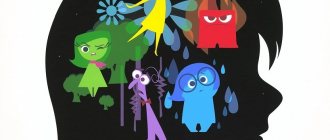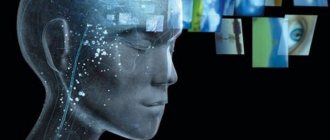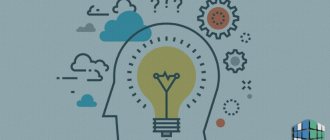Concept and essence
Illusion is a distorted perception of reality, which is based on deception of the senses. A person begins to perceive the imaginary as the real. The term “distorted” means that the object that an individual sees does not correspond to the surrounding reality. Distortion can be easily eliminated by understanding the reasons for its occurrence or by taking a series of measurements. Sometimes illusions are associated with what a person does not believe in.
Types of distortion:
- Illusions that are associated with water, the influence of a prism, are mirages, distortions of air due to hot steam. Based on physical phenomena.
- Illusions associated with the peculiarities of perception. Distortions are based on psychology and physiology.
The most studied are visual illusions. On the Internet or special textbooks you can find images that appear to move, but at the same time remain in place.
Forms of manifestations and physiology
Perceptual illusions are assessed according to the following criteria:
- The volume of illusions. The human ear can typically distinguish about 1,500 pitch levels. Regarding loudness, threshold differential studies show about 325 individually perceived levels in the region of greatest auditory sensitivity (1000 to 4000 cycles per second).
- For humans, the number of distinguishable tones is in the hundreds of thousands. However, when 2 sounds are heard in succession, the intensity or loudness of the 2nd is judged by comparing it with the 1st.
- Thus, a noise may sound louder than a whisper, and a "deafening" noise may cancel out all other sounds.
The steady boom that precedes an earthquake can drown out all audible sounds. This is why some people hear “silence” before a natural disaster.
It is worth mentioning separately about tactile illusions. The skin contains many "spots" that selectively react to either cold or heat. However, it may be that a very warm stimulus will produce a cold sensation if placed in a location that responds to cold.
This phenomenon can be compared to testing recently boiled water, which at first seems very cold and then hot. Thus, when a warm stimulus is perceived as cold, the illusion is called paradoxical cold.
Paradoxical heat, a less common experience resulting from the simultaneous stimulation of warm and cold spots. The sensation is sometimes called psychological heat.
The phenomenon of déjà vu is a feeling in which a past episode is repeated in the present. In fact, it is a merging of past and present, which results in the illusion of repeated experiences. A person re-experiences some experience under similar circumstances, and the brain projects the past situation onto current life events. This can be called a "hallucination" of the primary experience.
Theorists interpret experience as an event based on the reactivation of old memory traces. They rely on stimuli that resemble emotions experienced in the past.
Perceptual illusions were described by Louis Jolyon West, who noted that in psychology this event is associated with emotions, associations and strong expectations. Everything taken together often causes illusory delusions in everyday life.
In modern practice, there is the concept of substitution or cancellation:
- When a person expects to see someone, he may mistake the stranger for the object of his search.
- When trying to remember a song, a different chord comes to mind, similar to the desired composition.
Physiology in this case produces factor-stimulating events that help to remember incidents in life associated with episodes of specific actions.
History of discovery
The perception of reality began to receive attention in 1899. Illusions were familiar to people before, but were perceived as something mystical and frightening.
The first researchers in this direction conducted experiments to prove that illusions are based on people's expectations. These experiments involved lifting weights while blind. The buckets contained the same amount of sand, but people were told that they would now be allowed to lift the bucket even heavier. Participants in the experiment believed that buckets of equal weight were heavier than each other.
The first scientist to conduct such experiments was R. Muller. He asked people to estimate the same weight in containers of different sizes.
After conducting the experiments, Müller presented his personal arguments regarding similar distortions in the Würzburg school. Scientists from other European psychological schools began to develop and study this concept in the first half of the 20th century. They called illusions the anomalous phenomena that occur in nature - mirages, visual distortions due to the refraction of light. Psychologists from the Gestalt school shared this opinion.
Psychological theories and schools
The Gestalt school's "trace extinction" theory proposes that a physical trace (in the form of temporarily excited nerve cells) of the original stimulus remains in the brain even after that stimulus ceases. This trace influences the evaluation of the subsequent stimulus.
The strength of the mark, also called aftereffect, and the rate at which it disappears vary greatly in individual cases. People who are field dependent may express weaker traces of aftereffects.
The syllogism school interprets the concept of illusion. Köhler believed that human intelligence influences perceptual understanding.
The monkey used this as an example:
- She used a stick to get the banana.
- A stick in a horizontal position was considered an extension of the hand.
- To obtain food, the interpretation of this perception helped the monkey obtain the desired result.
Thus, the means to achieve the goal is always interpreted by the illusion of perception, as an object taken for something else thanks to the developed intellect.
Duncker, from the school of intellectual restructuring, studied the attitude towards sudden understandings. Illusion, in his opinion, was associated with associationist empiricism.
Any experience a person gains during his life can play a cruel joke on him:
- The structure of the actual field changes in an already established organization.
- Changes can arise due to changes in the structure of objects, rather than the environment.
- If a person with experience argues like a beginner, the structure will not accept his judgment.
Thus, the illusion of readiness in the principles of information perception can influence the opponent’s decision. Therefore, in many situations, an illusory picture of consequences is presented as a fact that has already happened.
Causes
Causes:
- Taking medications, alcohol, or drugs that distort the perception of reality.
- Natural physical processes in nature - mirages, rainbows, refraction of light through drops of water.
- A distortion imposed by the opinions of other people.
- Mental disorders, diseases.
- Physical pathologies. For example, in extreme heat, an individual may become delirious and see imaginary objects.
- Strong experiences, stress, nervous breakdowns, depression.
An interesting cause of illusions is synesthesia. This is a process of mixing feelings. Synesthesia is very common among creative people:
- Many musicians report that they can see special colors when playing melodies.
- Poets say that when looking at different images they hear sounds that are not really there.
Definition
The practical study of the phenomenon of “illusion” began with experiments in 1899, when test subjects were asked to estimate the weight of buckets equally filled with sand when they were lifted blindly. At the same time, the experimenter said that each subsequent bucket was filled with a large amount of sand. Participants in the experiment confirmed that lifting the load became more difficult.
A representative of the Würzburg school of psychologists, R. Müller, was the founder of this kind of experiments and, on their basis, suggested that weight distortion occurs under the influence of attitudes formed by the brain of the person being tested.
Psychologists of the Gestalt school, studying anomalous phenomena in nature (mirages, light refraction), proposed to consider their perception by people as an illusion.
The psychological concept of “illusion” implies the study of a person’s state in which he has an abnormal, deformed perception of the world around him.
Distortion of reality occurs in a person when his senses inadequately perceive objects and relationships with other people. Illusions can arise due to a person’s faith (in God, fate, destiny).
Liberation from illusions in psychology is finding the causes of their occurrence, an attempt to eliminate incorrect perceptions during psychological sessions or practical measurements.
Kinds
There are different types of illusions. Each type differs in the affected areas of perception, sensations, and general impact on the psyche.
Physical
The most obvious physical illusions are optical distortions. They are caused by various manifestations of the psyche, which are squeezed between a person and the object, object or phenomenon perceived by him. Examples:
- The moon high in the sky appears much smaller than at the horizon.
- If you submerge a straight stick halfway in water, the submerged end will appear smaller.
- After looking at something bright for a long time, an imprint of this object will remain in front of your eyes for a few seconds, but in reality it will not be there.
- It seems that the mountains are closer in clear weather with low air humidity than they actually are.
Cognitive
Cognitive distortions occur when an individual interacts not with the world itself, but with assumptions about it. This leads to the formation of unconscious conclusions that distort reality. Kinds:
- Ambiguous - Necker Cube, Rubin Vase.
- Distorting - geometric optical illusions. They are characterized by distortion of length, size, curvature, and location of geometric objects.
- Paradox distortions - appearing to be objects that are impossible or paradoxical.
A separate type of cognitive illusions is fiction.
Physiological
They arise under the influence of fatigue, tension, and emotional outbursts. Distortions of a physical and physiological nature are temporary. They disappear on their own after a certain period of time.
Physiological deviations are created against the background of discrepancies between real objects and erroneous phenomena. This group includes the false perception of visually reduced sizes of a large object.
Affective
They appear in healthy people physically and psychologically. They are associated with fatigue, mental stress, and strong emotions. Affective illusions appear in places unfamiliar to a person, when he expects bad things.
If a person is on the territory of an unfamiliar private house, and was frightened by a dog as a child, he will expect an attack by the animal. He can hear sounds that don't exist.
Pathological
Associated with mental disorders and psychological diseases. In this state, it is difficult for a person to distinguish reality from an imaginary illusion. The distortions go away on their own, but without proper treatment they return.
Verbal
Distorted perception of sound stimuli. The neutral speech of another person is perceived as a threat, and hostile reproaches, curses, and insults do not reach the person. If a radio or television is on, a person may feel that the announcers are talking to him.
Organic
They manifest themselves as distorted visual perception of objects, phenomena, and forms. The shape, size, color, and location in space are perceived incorrectly.
Awareness
They manifest themselves as an obsessive feeling that someone is present nearby. If treatment is not started, hallucinations and delusions will develop.
Perceptions
False perception of reality. When they manifest themselves, a person experiences sensory impressions that go against reality. Illusions can incline a person to incorrect judgments and opinions.
Pareidolic
The perception of patterns changes. When considering them, complex images develop in the human mind, which are arranged into fantastic pictures.
Examples of illusions in psychology
Widely known examples of perceptual distortions are fractal pictures. In fact, the images are static, but if you look closely at their central part, it seems as if it is moving.
Cognitive illusions manifest themselves through certain stereotypes, for example:
- fat people are good-natured, thin people are evil;
- the dog is angry, the cat is affectionate;
- dolphins save people;
- in life you need to achieve success (plant a tree, raise a son, ...);
- The necessary knowledge can only be obtained by entering an educational institution.
You can encounter illusion in everyday life. For example, if you look closely at the railway track, it seems that at a distance it is narrower than up close.
In psychology, some illusions are used for diagnosis. Thus, Rorschach blots are an example of a deliberately induced illusion used to reveal the intellectual abilities and other characteristics of the subject.
Irina Sherbul
How to stop living in a fictional world?
Often people live in a fictional world and do not realize it. Sometimes a person imposes distortions on himself in order to isolate himself from the dangers of the world around him, to close himself off from others. Such actions can lead to the development of mental disorders and psychological diseases. To correct the situation, you need:
- Learn to live according to a schedule. Make it up for every day. Make time for rest, work, hobbies, communication with friends and family. Maintain order in everything. This applies to the schedule, diet, order on the table, in the closets.
- Analyze experienced situations daily and think through ways to solve problems.
- Change your social circle, your field of activity. If you don’t want to lose your job, you need to ask for a vacation to rest.
You also need to pay attention to internal fears, false beliefs, and barriers. To cope with them, you need to consult a psychologist.
In psychology, there are different interpretations of the term “illusion”. Each of them is tolerant of the other. Illusion is a distortion of reality under the influence of external factors. They can be harmless or intrusive. In the latter case, you will need the help of an experienced psychologist.
Nature of occurrence
Illusions in psychology are phenomena of the human psyche caused by a number of natural causes.
Such reasons include:
- natural physical phenomena of a natural nature (optical distortions of reality);
- suggestion of surrounding people, forming a distorted perception of objects or phenomena;
- exposure to medications, drugs, strong alcohol;
- exposure to physical pathologies (high temperature, hypothermia);
- nervous breakdowns, strong feelings, stressful situations;
- mental disorders or diseases;
- synesthesia (mixing of sensory sensations during the creative process: the perception of a non-existent color when composing or listening to a melody, the formation of sounds while writing works while contemplating images or landscapes).
Diagnostics
The process of diagnosing an illusory state can be divided into several types.
The most common of them are:
- Illusions about one's personality. Determination of attitude towards oneself (negative or positive). Finding the origins of the formation of initial illusions. Determining methods for changing a sign or forming a new “starting point” for one’s own improvement.
- Illusions about surrounding people. Replacing real relationships that can be analyzed with fictitious ones that are far from the present, leading to conflict or a false interpretation of situations.
- Socially formed illusions. Stereotypes of behavior and relationships that have developed in society, which are projected onto people and form illusions in them. Such constructions include the following:
- a single person with a child cannot build their own happiness;
- a woman must meet beauty standards;
- you need to search for your “half” ad infinitum;
- a man must be strong and courageous.
- Mixed illusions. A combination of several types of illusions (about oneself, another person, family, self-affirmation in life), the embodiment of which leads to discomfort and many difficulties. As a rule, the efforts of one person do not coincide with the desires of another.
- Illusions about one's own future. The process of achieving goals in one’s illusory universe may conflict with the real state of affairs, abilities, capabilities and the availability of the necessary means. Illusions can turn into a “distant star”, causing a person to become apathetic, indifferent, and unwilling to fight for a dream.
Professional psychoanalysts can help people who contact them if the very purpose of the appeal is clearly defined. The patient must formulate for himself and the psychologist what result he would like to receive as a result of the sessions.
Hallucinations are a disorder that manifests itself in the perception of objects that do not really exist.
Hallucinations can have a clear localization in space and look natural, very similar to real objects, without raising the slightest doubt about their reality ( true hallucinations ), when patients believe that they are seen or heard by everyone around them. True hallucinations can occur with organic diseases of the brain (intoxication and infectious origin, traumatic brain injury), as well as with pathologies such as internal bleeding, influenza, typhus and others.
Hallucinations may not have a clear localization in space, but occur in the human body (in the chest, stomach, more often in the head) ( pseudohallucinations ), when patients report that they hear them or see them only. In this case, we are dealing with hallucinations that occur only with a mental disorder such as schizophrenia .
In addition to this division, hallucinations are classified according to the senses:
- auditory (call, call, beep, verbal - words, phrases, sentences. If a person hears comments or a discussion of ongoing events - commentary hallucinations; if they are ordered to do something - imperative;
- visual (individual elements ( photopsia ), non-existent animals, insects, people, individual scenes, one’s own double);
- olfactory (unpleasant odors (for example, spoiled meat, poison, smoke);
- tactile (sensation of cold or burning touches ( thermal ), sharply grasping ( haptic ) sensation of liquid or sticky on the body, spread of parasites, insects throughout the body;
- visceral ( the presence of something foreign inside the body).
Hallucinations are of a combined type, when, for example, a person simultaneously sees a sea monster that smells unpleasant and slides over his body.
In any case, hallucinations are a disorder of perception in the absence of a real object, arising on a painful basis and not being criticized by patients.
Therefore, if your loved ones tell you that they see non-existent objects or people or hear non-existent sounds, smells, voices, you should know that this is a manifestation of mental illness, and not some kind of stupidity or misunderstanding, which you can simply brush aside and ignore. If treatment is started in time, the patient can achieve significant improvement or even recovery. Help yourself or your loved ones!
We constantly detect plagiarism on our materials without providing a clickable follow link to them. In this case, without warning, we turn to Google DMCA , which leads to pessimization of the plagiarist. On the contrary, we welcome the popularization of our materials, but with the obligatory active follow link to this page psyhosoma.com/gallyucinacii-illyuzii-psixosensornye-rasstrojstva/ .










